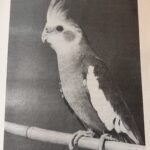
Scientific study of parrot diets falls flat
While wild bird (including chickens) have a lot of published studies on their diets, there are virtually no studies of parrot diets in captivity. This is unfortunate because we know that birds don’t live as long in captivity. Could it be diet? Wouldn’t it be great to know?
In 2012, a study was published called “Nutritional Levels of Diets Fed to Captive Amazon Parrots: Does Mixing Seed, Produce, and Pellets Provide a Healthy Diet?“—you can download the PDF here.
I was pretty excited to finally see a research paper studying captive bird diets. This study is the one study that vets point to when they tell you what to feed your bird. If they reference it, they usually call it the “Amazon study” as a shortcut.
This site strives to rely on scientific research for its conclusions, but it’s important not to just accept something because it’s published in a scientific journal. Studies do get discredited and retracted, although the rate is very small.
[…] retractions occur for a very small percentage of overall publications (fewer than 1 in 1,000 articles) […]
Retractions in academic publishing—Wikipedia
Weighing the merits of a study
When reading a scientific study, there are two factors to look at:
- Is it a well-conducted study
- Are the results convincing enough to apply the conclusions to our lives
Most of the time, both are true. The most common problem is #1 being true but #2 being false. You see this often when the media attempts to report the results of the study and by dumbing it down, they lose the subtlety and meaning.
Unfortunately, this Amazon study, while very well meaning and with lots of potential, is very deeply flawed and fails on both counts.
Summary
First, let’s talk about what the study does and what it concludes. The birds in the study were split into two groups and fed the following:
- Group 1: Seeds + fresh foods
- Group 2: Processed (pelleted) diet + fresh foods
The study closely measured what the birds consumed. Then, they performed nutritional analysis of what they consumed to determine levels of various nutrients, vitamins, and minerals.
Their conclusion was that the pelleted + fresh food diet was superior by being more nutritionally balanced and less deficient in certain vitamins and minerals.
In my analysis, I’ll first talk about how the study is flawed, and secondly talk about how the application of its results are flawed.
Flawed study
Conflicts of interest
The most egregious problem with this study is that it contains serious conflicts of interest and these conflicts are not disclosed. Many papers will have a specific section that calls them out. For example, it might say that money from the sugar industry was used to fund the paper.
I’m not saying any money changed hands, but this paper forever changed what vets recommend to feed captive birds and therefore had a great impact on industry. Vets almost universally recommend pellets.
So, let’s look at the paper and also the references. Note that Harrison’s, Roudybush, Kaytee, Hagen, Spectrum Brands, Lafeber, ZuPreem are all processed (pelleted) food manufacturers. A few of them also produce seed mixtures that contain pellets.
- Of the 41 references in the paper, 12 are from these manufacturers or the people that started them. That’s nearly 30% of them.
- The founder of Roudybush himself was consulted on formulating the seed mixture! Talk about stacking the deck.
The seed mix was composed of approximately 55% high-fat “oil seeds” (according to Roudybush) […]
Nutritional Levels of Diets Fed to Captive Amazon Parrots: Does Mixing Seed, Produce, and Pellets Provide a Healthy Diet?—Donald Brightsmith—Journal of Avian Medicine and Surgery
I’ll say here that there’s nothing wrong with consulting manufacturers of bird diets for their expertise on bird diets. Many of them have been formulating diets for decades. But you need to disclose this fact or you give the appearance of impropriety.
Over-feeding
The second main problem with the study is that the birds were massively overfed with their seed diets.
Birds consumed (only) 46% +/- 16% of the edible portions of seeds and nuts […]
Nutritional Levels of Diets Fed to Captive Amazon Parrots: Does Mixing Seed, Produce, and Pellets Provide a Healthy Diet?—Donald Brightsmith—Journal of Avian Medicine and Surgery
These birds were eating as low as only 30% of the seeds they were given, effectively feeding them three times as much as they were capable of eating. You can’t judge how much of a bird’s diet is seeds versus fresh foods if you overfeed them so much.
This overfeeding invalidates the nutritional analysis that underpins this paper. How many people feed their birds and throw out 60% of their food uneaten every day?
Judging health
The birds in this study were not objectively or subjectively studied to test their overall health. No checking of weight, blood work, subjective measures of things like feather condition, quality of feces, and so on. Everything was judged based on the nutritional content of what they ate.
And herein lies another very serious flaw. How do they decide what a good nutrient profile is for a diet? People like to talk about how a high fat diet is bad for birds but, just like with humans, there’s no proof. There are virtually no studies that establish minimum required levels of vitamins and minerals for birds. Exceptions include Vitamin D and Calcium.
So, there’s some bad logic going on here. They claim to know the right mix of nutrients a bird needs, they overfeed them a diet which encourages imbalance, ignore the actual health of the bird, then judge health based on what they ate. It’s like telling a 99 year old man that runs marathons that they have a bad diet because they eat too much cholesterol.
Flawed application
If we presume the results of this study to be correct, can we and should we really apply it to our birds? I argue that, for many reasons, we simply cannot.
Sample size
Sample size is something that is difficult to understand but crucially important. If the news reports a study that says eggs are bad and it’s a study of 10 people, that’s not something you should apply to your life. At best, it just indicates that a larger study must be performed.
As shown in this explanation of sample size, a sample size of 10 means a margin of error of 31.6%—this means that if one subject is an anomaly or is misinterpreted, the results will swing by 31.6%—if your conclusion is that one group did 20% better than the other, your results have been rendered irrelevant. The margin of error drops to 10% at 100 participants and to 3% at 1,000 participants.
Going back to the egg study example, if 1 of the 10 people in the study has some sort of genetic anomaly that affects how they process eggs, that could swing the study in the other direction: eggs are great! This is why you need larger studies to make solid conclusions.
When you read political surveys, you’ll see that they are typically in the neighborhood of 1,000 people. Massive research studies also have at least 1,000 people in them, often a lot more.
The sample size in this study completely makes this not applicable to your bird. It’s kind of shocking to discover this, but four (4) birds were given the diet being studied and the control group was three (3) birds. Only 7 birds were in this study! If the result of just one bird were to have been different, the conclusion of the paper would have completely the opposite.
I can’t blame them for having a small study as studies are expensive. However, I’m arguing that the small size means the results are not conclusive. It just means that more study needs to be done.
Single species
Again, the study probably couldn’t afford to do multiple species, but it’s worth noting that this was only Amazon parrots. As we all know, parrots eat very different diets. Some are primarily seed-eaters, some eat vegetables, some eat fruit, some eat insects, and some even eat meat or nectar. We can’t really apply the results from one species to multiple species.
Conclusion
Any time something new is studied, it tends to start with a very small set of subjects. It’s less expensive and it’s a way to test your hypothesis before doing further study. That’s what this Amazon study is. The next step might be a study of 100 subjects and then maybe 1,000 later if the subject is important enough.
A study of 7 birds is interesting but not conclusive.

